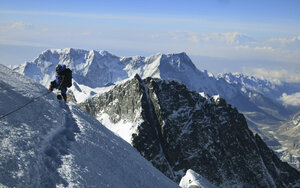#EverestNoFilter: Why two climbers want to Snapchat their Everest ascent
Cory Richards and Adrian Ballinger will document their ascent in real time, marking a step forward in both technology and recovery from Everest's recent tragedies.

A climber pauses on the way to the summit of Mount Everest, in the Khumbu region of the Nepal Himalayas, in this May 2013 photo released by mountain guide Adrian Ballinger of Alpenglow Expeditions.
Adrian Ballinger/ AP
Two seasoned American climbers are attempting to summit Mount Everest – and they plan on live-sharing the whole thing.
Alpenglow Expeditions guide Adrian Ballinger and National Geographic photographer Cory Richards plan to chronicle their entire ascent up the world's tallest mountain via their Snapchat account @EverestNoFilter.
"We chose Snapchat because 'snaps' – unlike posts to Instagram or Facebook – must be posted immediately from a phone’s camera," Mr. Ballinger writes for Outside magazine. "If we're successful, you'll have a complete chronicle of our journey."
Ballinger and Richards are also sharing Instagrams of their journey with hashtag #EverestNoFilter.
"Once we're on the mountain, with the help of new satellite technology, we'll be able to keep you updated in real time, and if all goes as planned, from the top of the world itself," write the climbers on their website.
"Everest has seen tragedy and controversy grow over the years and with this expedition, we hope to raise awareness and funds to directly impact local communities still devastated by the earthquake and lead the way in sustaining this mountain for both the people of her slopes and those who dream about reaching her peak. This is truly #EverestNoFilter."
Richards and Ballinger hope to gain more than just Snapchat followers as they complete their climb.
"Ultimately what we want is a positive future for Everest, and for those who work and recreate on the mountain," writes Ballinger. "Getting there will require thought, discussion, and effort from everyone involved. We hope our story can help to illuminate some of the issues, and possible solutions."
Nine Nepalese guides reached the summit of Mount Everest on Wednesday, becoming the first climbers to complete the climb in the last two years.
During this time, Everest has witnessed a number of tragedies. In 2014, an avalanche killed 16 Sherpa guides. Then, last April, a 7.8-magnitude earthquake in Nepal killed about 9,000 people and left two million homeless. The 2015 quake triggered an avalanche on Everest that killed 18 people, including both Sherpa guides and foreign climbers.
Since Tenzing Norgay and Edmund Hillary became the first men to summit Everest in 1953, the mountain has been climbed over 7,000 times by over 4,000 people. Of the thousands of ascents, only 193 have been completed without the assistance of bottled oxygen. Ballinger and Richards will attempt "going without" as well.
The duo are experienced climbers. Ballinger has already summited Everest six times, but this year's climb will be his first attempt without supplemental oxygen. Richards has climbed Lhotse, the fourth-tallest mountain in the world, without oxygen, but he has yet to summit Everest.
"Both of the men are all too familiar with the glossy pictures and epic storytelling that come out of most Everest expeditions," Eric Lemke writes for Gear Junkie. "So they decided to show the unfiltered view of what climbing a mountain like Everest can be by using Snapchat," where users cannot edit pictures or video.
The climbers say they will pass the phone around their team to capture Snapchats from the perspectives of everyone on their team, including Sherpa guides and the expedition doctor. Since starting their account a few weeks ago, Ballinger and Richards' Snapchats are now getting tens of thousands of views.
"I've always found climbing to be a selfish pursuit – I love it, but I also like being able to tell the stories of it and hopefully inspire or raise questions with people at home," Ballinger told CBS.

